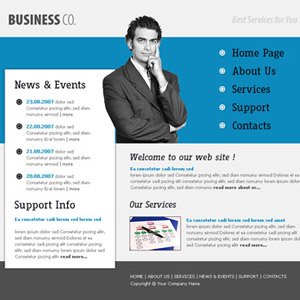Quick and Cheap Guide To Creating A Business Website

Creating a business website shouldn’t require much time or money, but it does require some planning and research before you make long-term commitments. Getting a business website off the ground is a step by step process but if you follow these five steps, you can have your new website up and running within a week:
Creating A Business Website #1—Hosting
Whether you’re creating a business website or a personal website, you need hosting. Large businesses buy their own servers and data centers, and then they hire system administrators to run the computers and software at a cost of millions of dollars a year.
Chances are that’s beyond your league—but you still need a server, a data center, and a system administrator. Since you can’t afford any of those on your own, you can go to a hosting company which rents you part of a server, part of a data center, and part of their system administrators’ time.
Hosting for a new website will cost you between $5 and $10 a month—a paltry cost compared to the possible revenue from even one customer in many business models.
When considering hosting, remember that you’re sharing resources with hundreds or thousands of other people, so you want to get hosting from a company that doesn’t oversell its resources. The best way to find a good fit for your company is to take advantage of free trials to see whether your piece of the server runs fast enough, or your piece of the data center has the necessary bandwidth to support your business, or your part of the system administrators’ time is spent making things easy for you.
Many of the top web hosting companies will fight for your business and try to give you the best value and quality service.
Creating A Business Website #2—Choose Your Software
Creating a business website means you need to publish information about your business in the HyperText Markup Language (HTML) which Web browsers turn into webpages.
Learning basic HTML is easy, but unnecessary—you can create a simple HTML document in seconds by typing it up in Microsoft Word or Libre Office and clicking Export to HTML from the File menu.
But running an entire website—with dozens or hundreds of webpages—out of Microsoft Word will waste your time and make it difficult to create professional-looking pages.
A better solution is to use a Content Management System (CMS). The most popular today, by far, is WordPress. Other popular free content management systems are Drupal and Joomla. WordPress is the one that is moving in leaps and bounds though. 🙂
You can try free demo versions of most content management systems to learn how they work and find the one you like best. When you do find one that works for you, make sure you choose a website hosting company that offers free no-hassle installation of it.
(Also make sure they install the current version of your preferred content management system. Hosting companies which only offer older versions of software probably won’t be able to offer you the latest security patches, so your data may get hacked.)
Personally I highly recommend the Thesis WordPress theme because it is just so flexible and suits most types of websites.
Creating A Business Website #3—Choose A Domain
A domain name is one of the least important decisions you’ll make (unless you do it horribly wrong), but it’s one of the decisions on which I see people waste hours.
Your domain name should be short and easy to remember, and it should avoid vulgarities or anything which might scare away potential customers. Avoid being too clever.
People worry over domain names because they think they’re stuck with it forever—but you’re not. It’s easy to change domain names at any time without any impact on your incoming traffic or search engine ranking. I have done this three times now, crazy I know.
Creating A Business Website #4—Starting Your Site
Keep in mind when you’re creating a business website that most businesses need these four pages on their site:
1. Main page (also called home page): This is what people will see when they type in your domain name. It should have basic information about your business and links to other pages on your site with more information.
2. About us: potential customers want to know who they’re doing business with, so take a moment to tell them about you and your business.
3. Products or Services: whatever you sell, this is the page to describe it. If you sell more than an handful of products or services, give each one its own page.
4. Why buy from us: tell people why they should buy from you—and not from your competition.
Creating A Business Website #5—A Reason To Visit
Everything else up until now in creating a business website has been a formality—it’s given you a Web presence. Too many businesses stop at this point and wonder why they hardly ever get any traffic—and they start to think this whole Web thing is a scam to make them pay for a domain name and hosting.
But in order for a website to work, you need to give people a reason to visit.
People visit Amazon.com because they know they can buy items there cheaply. People visit NYTimes.com because they know they can get news there. Why should people visit your site?
The easiest way for you to attract visitors to your site is to offer them useful information. Most sites offer this information on a blog.
The information you offer will depend on your business. It should be related to your business, but it should be interesting to your customers.
Don’t tell people your latest sales numbers or how you plan to expand the business next fall. Tell them something they can use to make an immediate improvement in their life.
After you publish a few of these posts, use the website statistics software provided by your hosting company (or sign up for Google Analytics, a free service) to see which of your blog posts are attracting the most traffic. Then write more posts like that.
Most small businesses I work with run one to five blog posts a week. One post a week is great for traditional off-line businesses, while posting more fresh content in a week can help online businesses quickly attract new customers to their website.
Conclusion
Find hosting, choose software, pick a domain, build a site, and attract traffic—that’s all it takes for you to create a business website.
 Is a Custom Design Essential to Your Blog’s Success?
Is a Custom Design Essential to Your Blog’s Success? Social Media Makes Sales Enablement Easy By Showing How Smart Business Can Be
Social Media Makes Sales Enablement Easy By Showing How Smart Business Can Be 14 Tips To Help You In Marketing Your WordPress Site
14 Tips To Help You In Marketing Your WordPress Site Divi 3.0 Special Discount: 20% OFF Divi Theme from ElegantThemes
Divi 3.0 Special Discount: 20% OFF Divi Theme from ElegantThemes
{ 11 Responses }